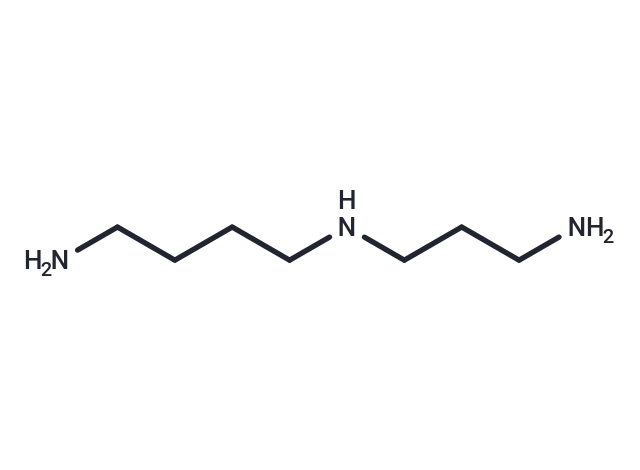Shopping Cart
- Remove All
 Your shopping cart is currently empty
Your shopping cart is currently empty

Spermidine (N-(3-Aminopropyl)-1,4-diaminobutane) inhibits NOS1 (nNOS). Spermidine binds and precipitates DNA and may be used for purification of DNA binding proteins. Spermidine activates PNK (polynucleotide kinase T4). Spermidine binds to and activates NMDA and has been shown to potentiate NMDA-induced currents in a concentration-dependent manner.

| Pack Size | Price | Availability | Quantity |
|---|---|---|---|
| 100 mg | $45 | In Stock |
| Description | Spermidine (N-(3-Aminopropyl)-1,4-diaminobutane) inhibits NOS1 (nNOS). Spermidine binds and precipitates DNA and may be used for purification of DNA binding proteins. Spermidine activates PNK (polynucleotide kinase T4). Spermidine binds to and activates NMDA and has been shown to potentiate NMDA-induced currents in a concentration-dependent manner. |
| In vitro | METHODS: Human neuroblastoma cells SH-SY5Y were treated with Spermidine (0.05-10 µM) for 24-48 h. Mitochondrial metabolic activity was measured by MTT assay and ATP production assay. RESULTS: No effect of Spermidine was observed after 24 h. 0.1 and 1 µM Spermidine significantly increased cellular metabolic activity and ATP production after 48 h of treatment. The most effective concentration of Spermidine, 0.1 µM, induced an 8.2% increase in metabolic activity and a 4% increase in ATP production. [1] METHODS: The retinal pigment epithelial cell line ARPE-19 was treated with H2O2 (300 µM) and Spermidine (10 µM) for 24 h. Apoptosis was detected by Flow cytometry. RESULTS: 300 µM H2O2 significantly increased the frequency of annexin V-positive cells to approximately 25%, but Spermidine significantly inhibited this increase. The results suggest that Spermidine attenuates H2O2-mediated oxidative stress-induced apoptosis in ARPE-19 cells. [2] |
| In vivo | METHODS: To study the effects on diabetes, Spermidine (10 mM) was administered orally in water to non-obese diabetic (NOD) mice (type 1 diabetes mouse model) for thirty weeks. RESULTS: Treatment of NOD mice with Spermidine resulted in a higher incidence of diabetes, although pancreatic insulitis was not altered.Spermidine modulated pancreatic tissue polyamine levels and increased signs of autophagy.Spermidine resulted in an increase in the proportion of pro-inflammatory T-cells in the pancreatic lymph nodes (pLN) of diabetic mice. [3] |
| Alias | N-(4-Aminobutyl)-1,3-diaminopropane, N-(3-Aminopropyl)-1,4-diaminobutane |
| Molecular Weight | 145.25 |
| Formula | C7H19N3 |
| Cas No. | 124-20-9 |
| Smiles | NCCCCNCCCN |
| Relative Density. | 1.00 g/cm3 at 20℃ |
| Storage | Pure form: -20°C for 3 years | In solvent: -80°C for 1 year | Shipping with blue ice. | ||||||||||||||||||||||||||||||||||||||||
| Solubility Information | 5% DMSO+95% Saline: 1.67 mg/mL (11.5 mM), In vivo: Please add co-solvents sequentially, clarifying the solution as much as possible before adding the next one. Dissolve by heating and/or sonication if necessary. Working solution is recommended to be prepared and used immediately. DMSO: 33.33 mg/mL (229.47 mM), Sonication is recommended. H2O: 100 mg/mL (688.47 mM), Sonication is recommended. | ||||||||||||||||||||||||||||||||||||||||
Solution Preparation Table | |||||||||||||||||||||||||||||||||||||||||
5% DMSO+95% Saline/DMSO/H2O
DMSO/H2O
| |||||||||||||||||||||||||||||||||||||||||

Copyright © 2015-2025 TargetMol Chemicals Inc. All Rights Reserved.